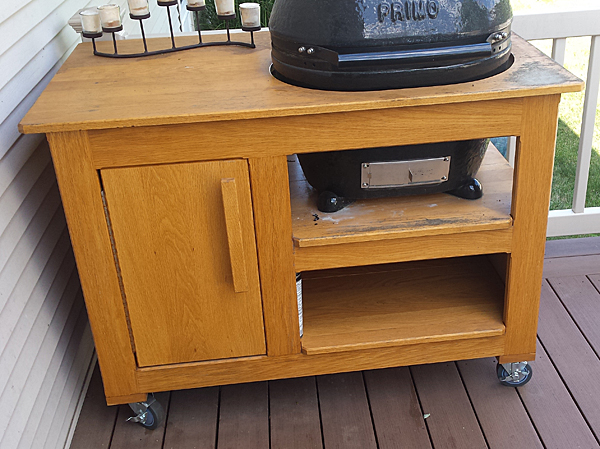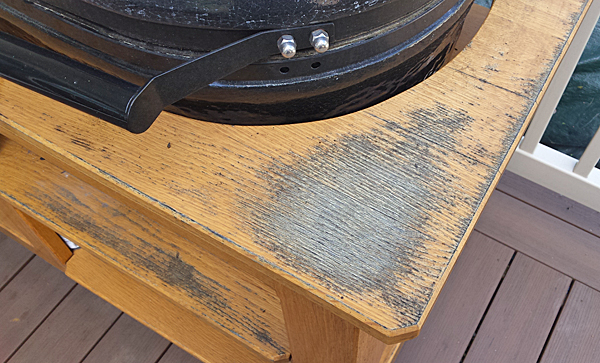
Last year I built this grill table for my son using riftsawn white oak, and in just that amount of time, the finish has deteriorated as you can see (below). When I finished the table originally, I brushed on Minwax® Helmsman® Spar Urethane — four coats on the horizontal surfaces and three coats on the vertical surfaces. We live in northern Illinois, so we have cold winters and hot summers. The table has not been covered because it is used quite often, and it sits in direct sunlight from midmorning until noon.
I talked to the folks at the local Sherwin Williams who think that seasonal expansion and contraction could be the problem: the varnish has cracked, allowing moisture to reach the wood. I would like to refinish the affected surfaces. I know a cover will help, too. Do you have suggestions or a solution to prevent this from happening again? – Bob Claerhout
Chris Marshall: I think the folks at Sherwin Williams are correct. Expansion and contraction from wood movement and temperature extremes are going to eventually deteriorate any finish. So will sunlight and standing water. Mother Nature is not a friend to finished wood. My advice would be to keep that grilling table covered up and dry when not in use. The less exposure the wood has to the elements and UV light, the longer the next coat of film-forming finish (which is what any varnish is) will last.
I’ve taken a different tack on outdoor furniture lately. Instead of coating the wood and trying to hermetically seal it under a film, I just let it breathe. I apply a tinted deck preservative with UV inhibitors to the bare wood and skip the film finish altogether. Why? Because when the stain color fades, I won’t have to strip the old finish off or sand excessively. I can just scrub the project with soap and water to remove the oxidation and grime, and brush on another coat of deck preservative. I’ve decided not to fight Mother Nature — just hold her at bay for a while.
Tim Inman: Boat owners know the drill: Sand and re-varnish every spring. Your table will need the same regimen if you want it to look like a piece of clear finished furniture while treating it like an “outdoor” dog. Sunlight, heat and cold: these are the things that destroy finishes best. As the weather factors take their toll, the finish becomes less elastic — more brittle. As the wood shrinks and swells due to moisture and heat changes, the finish develops micro cracks that let in air and water. The air and especially the water react with the tannins in your oak, and — Whamo! — you get that grey stain you don’t like. It is inevitable unless something changes in the life and care of that wood. So, “How to prevent this happening again?” Bring it inside when not in use or at least put a protective cover over it to keep it dry, dark and cool.






